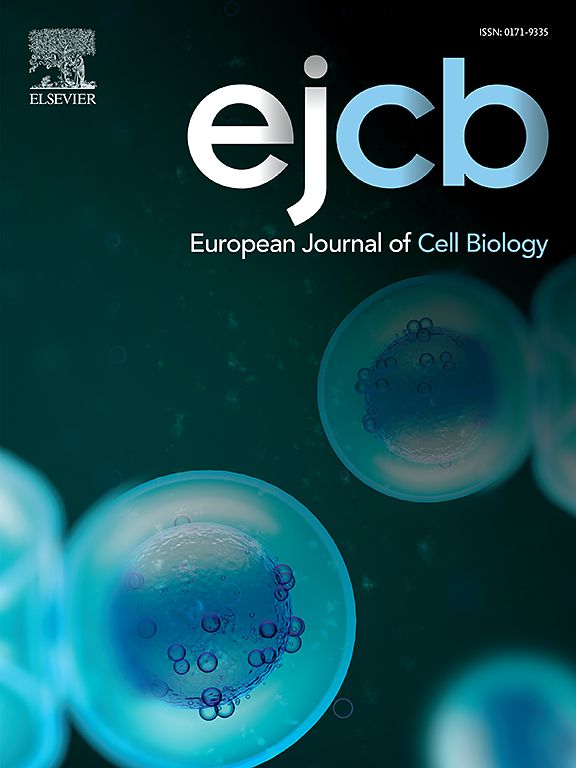人二胺氧化酶经历胞吞作用并与质膜单胺转运蛋白共定位,表明细胞内组胺降解
IF 4.3
3区 生物学
Q2 CELL BIOLOGY
引用次数: 0
摘要
分泌型人二胺氧化酶(hDAO)是唯一能够使细胞外组胺失活的酶。组胺是激活肥大细胞高浓度释放的关键介质,引起各种不愉快甚至危及生命的症状。重组hDAO被内化到各种细胞类型中。然而,含有rhDAO的细胞内囊泡不与溶酶体共定位,这表明rhDAO不太可能是直接降解的目标。内化后,rhDAO在不丧失酶活性的情况下迅速胞外化并重新内化。全内反射荧光显微镜显示,rhDAO在内皮细胞中发生胞吞作用。胞吞事件的数量是剂量依赖性的和可饱和的,表明一个特定的,受体介导的摄取机制。加入未标记的DAO、肝素和肝素结合基序突变的DAO可显著减少胞吞事件的数量。小鼠经静脉注射rhDAO后,不仅在胸主动脉内皮细胞层内,而且在内皮细胞层下的小泡中检测到rhDAO。在生物体液中未检测到hDAO在细胞外囊泡中的定位。在各种细胞类型中,胞内囊泡rhDAO与质膜单胺转运蛋白(PMAT)共定位,但不与有机阳离子转运蛋白共定位1-3。组胺被描述为所有四种转运蛋白的底物。几十年来,人们已经发现了DAO的细胞质囊内定位,但没有明确的生理功能。新发现的胞吞作用可能将DAO转运到组织广泛分布的间质室,特别是在怀孕期间。DAO与组胺转运蛋白PMAT的囊泡共定位表明,在这些特征不明显的囊泡中,细胞内组胺降解。本文章由计算机程序翻译,如有差异,请以英文原文为准。
Human diamine oxidase undergoes transcytosis and colocalizes with the plasma membrane monoamine transporter indicating intracellular histamine degradation
Secreted human diamine oxidase (hDAO) is the only enzyme capable of extracellular histamine inactivation. Histamine is the key mediator released at high concentrations from activated mast cells causing various unpleasant to life-threatening symptoms. Recombinant hDAO is internalized into various cell types. However, rhDAO-containing intracellular vesicles do not colocalize with the lysosomes indicating that rhDAO is unlikely targeted for direct degradation. After internalization rhDAO was rapidly exocytosed without loss of enzymatic activity and re-internalized. Total internal reflection fluorescence microscopy revealed that rhDAO undergoes transcytosis in endothelial cells. The number of transcytosis events was dose-dependent and saturable indicating a specific, receptor-mediated uptake mechanism. Addition of unlabeled DAO, heparin and heparin-binding motif mutated DAO significantly reduced the number of transcytosis events. After intravenous injection of rhDAO into mice it was detected in vesicles not only within but also below the endothelial cell layer of the thoracic aorta. Localization of hDAO within extracellular vesicles was not detected in biological fluids. In various cell types intracellular vesicular rhDAO colocalized with plasma membrane monoamine transporter (PMAT), but not with the organic cationic transporters 1–3. Histamine is described to be a substrate for all four transporters. Cytoplasmic intravesicular localization of DAO has been detected for many decades but no definite physiological function could be assigned. Newly discovered transcytosis might transport DAO into the interstitial fluid compartment with widespread tissue distribution, especially during pregnancy. Vesicular colocalization of DAO with the histamine transporter PMAT indicates intracellular histamine degradation within these poorly characterized vesicles.
求助全文
通过发布文献求助,成功后即可免费获取论文全文。
去求助
来源期刊

European journal of cell biology
生物-细胞生物学
CiteScore
7.30
自引率
1.50%
发文量
80
审稿时长
38 days
期刊介绍:
The European Journal of Cell Biology, a journal of experimental cell investigation, publishes reviews, original articles and short communications on the structure, function and macromolecular organization of cells and cell components. Contributions focusing on cellular dynamics, motility and differentiation, particularly if related to cellular biochemistry, molecular biology, immunology, neurobiology, and developmental biology are encouraged. Manuscripts describing significant technical advances are also welcome. In addition, papers dealing with biomedical issues of general interest to cell biologists will be published. Contributions addressing cell biological problems in prokaryotes and plants are also welcome.
 求助内容:
求助内容: 应助结果提醒方式:
应助结果提醒方式:


